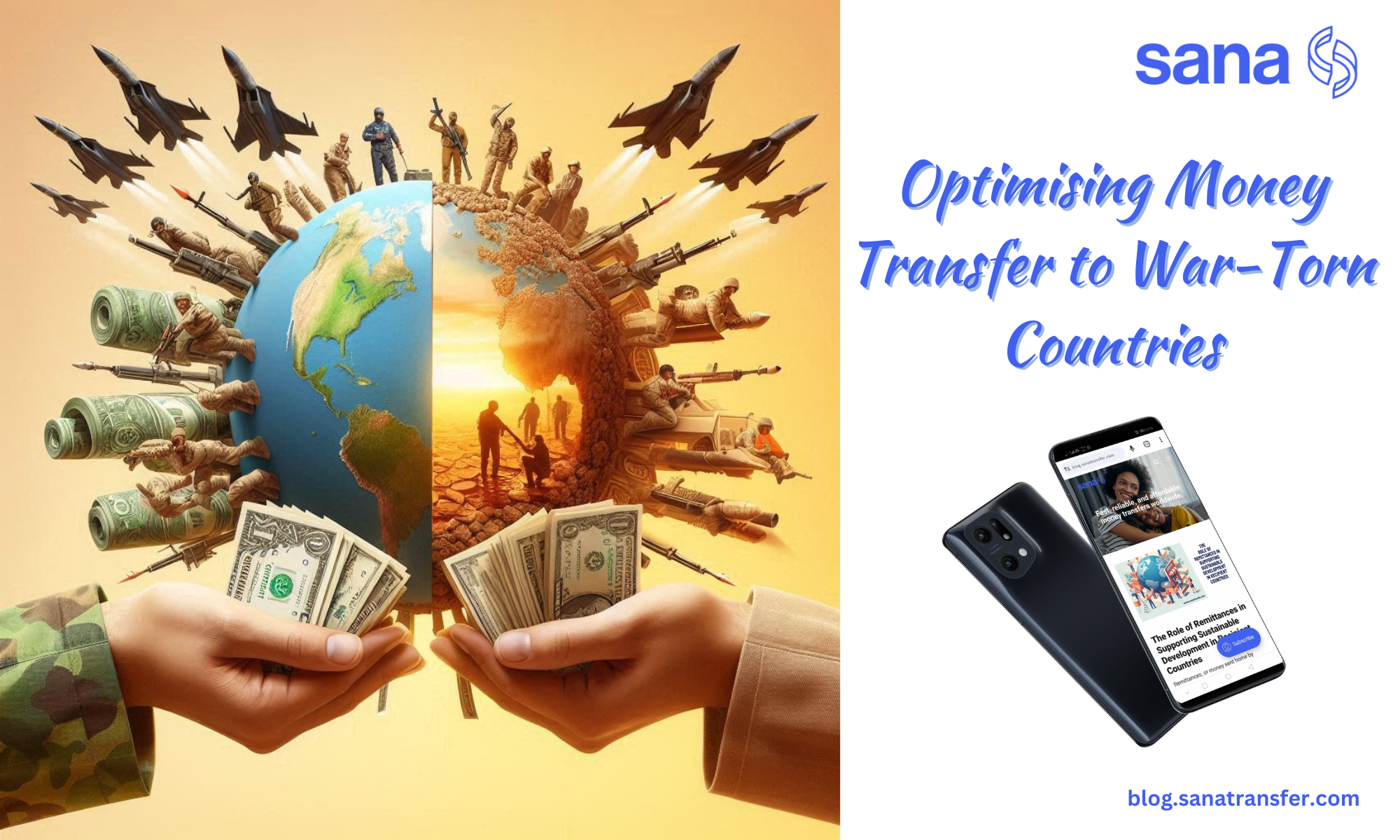Optimising Money Transfer to War-Torn Countries

Unfortunately for us all, we live in a world that wages war on itself. People, governments, ideologies, corporations and even religious fanatics wage war on others wreaking havoc on entire societies.
During and in the aftermath of these conflicts, war-torn countries face a multitude of devastating challenges. Infrastructure crumbles, essential services like healthcare and sanitation are disrupted, and entire populations are displaced from their homes. Basic necessities like food, water, and shelter become scarce, leaving people struggling to survive.
In the last decade, there have been new conflicts springing up, most recently the Russia-Ukraine conflict. Other ongoing ones include the Somali unrest, skirmishes in Afghanistan and other porous middle-eastern parts; insurgency in west and central Africa.
In these desperate situations, financial aid is a lifeline, allowing humanitarian organisations to provide critical assistance, deliver emergency supplies, and support the long road to rebuilding. Also, families, friends and loved ones of those affected by the conflict in the diaspora would also need ways to reach out to their own, through money transfers, supporting them.
Read Also: Traditional Money Transfer Methods Vs Modern FinTech Methods
However, ensuring the maximum impact of financial aid requires careful consideration. Optimising money transfers is crucial to getting the most value out of every penny donated. By minimising fees and maximising transparency, those involved can ensure these vital resources reach those who need them most and empower war-torn communities to rebuild.
What Are The Most Common Issues with Traditional Money Transfers In War-torn Countries?
Unfortunately, while attempting to get these resources to these war-torn zones, traditional money transfer methods often fall short, hindering the effectiveness of financial aid. Here's a closer look at the most common issues:
High Transfer Fees
Putting out money transfers through traditional banking channels often involves hefty fees. These fees can eat significantly into the total aid amount, reducing the resources available for those in need. This causes a situation where a significant portion of the donated funds are lost before they even reach the war-torn country.
Black Market Exchange Rates
Converting foreign currency in war zones can be a challenge and traditional methods might have to rely on black markets where exchange rates are often unfavourable. Unfortunately, threading this path means the intended value of the aid gets eroded, leaving beneficiaries with less than what was originally donated.
Lack of Transparency
This problem arises as tracking the usage of these funds after they reach the war-torn country can be difficult with traditional methods. This lack of transparency creates uncertainty about whether the aid is reaching its intended recipients and how it's being used. Donors and beneficiaries alike need to be confident that the money is making a real difference.
Security Concerns
It is very risky, delivering large amounts of cash to war zones as theft or robbery is prevalent and aid workers and beneficiaries will be put in danger. Transporting cash can also be logistically challenging and time-consuming in such a fragile environment, affecting the safe arrival of funds to these zones.
These problems cause one to ask, how then can these funds get to these conflict zones easily, securely and be put to good use?
Read Also: Major Problems Online Remittance Platforms Face When Sending Remittances To Southeast Asia
III. Strategies for Optimising Money Transfers
Now that we understand that traditional methods often fall short in war-torn regions; innovative approaches would have to be brought in to significantly improve the effectiveness of financial aid in the form of money transfers to these war-torn zones. Here are some key strategies for optimising money transfers:
A. Utilising Reputable Organisations
First on the list, those involved must make these money transfers through established NGOs and Charities in order to leverage their experience and expertise. These organisations have extensive networks within war-torn regions, ensuring aid reaches the most vulnerable populations. Their established infrastructure translates into efficient delivery and lower overhead costs, maximising the impact of your donation.
B. Exploring Alternative Transfer Methods
Another way is utilising Mobile Money Transfer Services as they offer a secure and efficient alternative; allowing for direct deposits to beneficiaries' mobile wallets, eliminating the need for traditional banking systems and black market exchanges. This ensures transparency, reduces fees, and provides a safe way for people to access funds.
Voucher Systems and Targeted Cash Distribution systems can also be used for specific goods and services, ensuring aid reaches intended beneficiaries. This also comes in handy to help rebuild local markets and stimulate the local economy. Targeted cash distributions, where recipients receive cash directly, empower individuals to make choices that best meet their needs. Here, trust in established organisations is crucial to ensure responsible use of funds.
C. Promoting Local Economies
By directing aid money towards local businesses, donors can stimulate the war-torn economy and create jobs. Purchasing supplies and services locally injects money directly back into the community, fostering long-term recovery and sustainable development.
Cash for Work Programs are also applicable as temporary employment opportunities while rebuilding essential infrastructure or providing vital services. This approach offers beneficiaries a sense of dignity while addressing immediate needs and strengthening local economies.
By adopting these strategies, we can ensure that financial aid reaches those who need it most, has a lasting impact, and empowers war-torn communities to chart a path towards a brighter future.
Ensuring Transparency and Accountability in Money Transfers
Finding ways to deliver aid effectively through money transfer is one aspect; there also comes the part of ensuring these monies are used responsibly. Transparency and accountability are fundamental to building trust with both donors and beneficiaries. To achieve this, stakeholders involved must:
- Ensure clear communication with beneficiaries to let them track what their monies are being used for. This builds trust and empowers them to participate in the aid process. For example, a community receiving aid for a new water well. Clear communication would explain the project, its timeline, and how the community can provide feedback. Regular updates through community meetings, SMS alerts, or local radio broadcasts can foster a sense of ownership and encourage responsible use of resources.
- Monitoring and evaluating how funds are being used and identifying any potential issues. This might involve site visits, interviews with beneficiaries, and data collection on project progress to assess the impact of aid programs and help improve their effectiveness. Using our previous example, this strategy asks questions like: Did the new water well provide clean water for the entire community? Were there any unforeseen challenges? By analysing results, organisations can adjust their approach to maximise future impact.
- Utilising technology for transparent trackinglike the Blockchain technology. This technology is popular for providing real-time tracking of funds which reduces the risk of misuse and increases accountability. It guarantees that each step in the transfer process can be documented on a secure, tamper-proof ledger, giving everyone involved a clear picture of how the money is moving. Mobile money transactions with digital receipts can offer greater transparency for both donors and beneficiaries. By providing a record of how funds are spent, beneficiaries are empowered to hold aid organisations accountable.
These highlighted strategies improve the effectiveness of aid programs, and ultimately contribute to a more sustainable future for war-torn communities.
Conclusion
In war-torn countries, financial aid through money transfer plays a critical role in reviving shattered communities. Yet, effective aid distribution involves more than mere monetary transactions; it necessitates minimising fees, utilising established networks, and adopting innovative methods to maximise impact.
Also, incorporating reputable organisations, exploring alternative transfer channels, and bolstering local economies are pivotal strategies. This shows us also that transparency, accountability, and technological advancements bolster aid programs' effectiveness, fostering sustainable development.
The overarching objective highlighted in this write-up extends beyond immediate relief: optimised financial aid empowers war-torn regions to rebuild autonomously, fostering sustainable development and brighter prospects. When resources are utilised efficiently and responsibly, communities aren't just assisted momentarily but are equipped with the means to thrive independently.
Read Also: Best Ways To Send Money Out Of Canada
